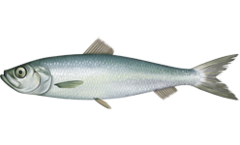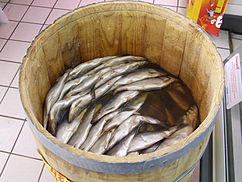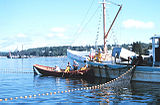
Atlantic herring
Background to the schools Wikipedia
SOS believes education gives a better chance in life to children in the developing world too. Visit the SOS Children website at http://www.soschildren.org/
| Atlantic herring | |
|---|---|
 |
|
| Conservation status | |
 Least Concern ( IUCN 3.1) |
|
| Scientific classification | |
| Kingdom: | Animalia |
| Phylum: | Chordata |
| Class: | Actinopterygii |
| Order: | Clupeiformes |
| Family: | Clupeidae |
| Subfamily: | Clupeinae |
| Genus: | Clupea |
| Species: | C. harengus |
| Binomial name | |
| Clupea harengus Linnaeus, 1758 |
|
 |
|
| Distribution on a NASA SeaWIFS image | |
Atlantic herring (Clupea harengus) is a herring in the family Clupeidae. It is one of the most abundant fish species on earth. Atlantic herrings can be found on both sides of the Atlantic Ocean, congregating in large schools. They can grow up to 45 centimetres (18 in) in length and weigh more than 0.5 kilograms (1.1 lb). They feed on copepods, krill and small fish, while their natural predators are seals, whales, cod and other larger fish.
The Atlantic herring fishery has long been an important part of the economy of New England and the Canadian Maritime provinces. This is because the fish congregate relatively near to the coast in massive schools, notably in the cold waters of the semi-enclosed Gulf of Maine and Gulf of St. Lawrence. North Atlantic herring schools have been measured up to 4 cubic kilometres (0.96 cu mi) in size, containing an estimated 4 billion fish.
Taxonomy
The small-sized herring in the inner parts of the Baltic Sea, which is also less fatty than the true Atlantic herring, is considered a distinct subspecies (Clupea harengus membras) ("Baltic herring"), despite the lack of a distinctive genome.
Description
Atlantic herring have a fusiform body. Gill rakers in their mouths filter incoming water, trapping any zooplankton and phytoplankton.
Atlantic herring are in general fragile. They have large and delicate gill surfaces, and contact with foreign matter can strip away their large scales.
They have retreated from many estuaries worldwide due to excess water pollution although in some estuaries that have been cleaned up, herring have returned. The presence of their larvae indicates cleaner and more–oxygenated waters.
Range and habitat
Atlantic herring can be found on both sides of the ocean. They range across North Atlantic waters such as the Gulf of Maine, the Gulf of St Lawrence, the Bay of Fundy, the Labrador Sea, the Davis Straits, the Beaufort Sea, the Denmark Straits, the Norwegian Sea, the North Sea, the English Channel, the Celtic Sea, the Irish Sea, the Bay of Biscay and Sea of the Hebrides. Although Atlantic herring are found in the northern waters surrounding the Arctic, they are not considered to be an Arctic species.
Ecology
Herring-like fish are the most important fish group on the planet. They are also the most populous fish. They are the dominant converter of zooplankton into fish, consuming copepods, arrow worms chaetognatha, pelagic amphipods hyperiidae, mysids and krill in the pelagic zone. Conversely, they are a central prey item or forage fish for higher trophic levels. The reasons for this success is still enigmatic; one speculation attributes their dominance to the huge, extremely fast cruising schools they inhabit.
Orca, cod, dolphins, porpoises, sharks, Rockfish, seabird, Whale, squid, Sea Lion, Seal, tuna, Salmon, and fishermen are among the predators of these fishes.
Herring are pelagic–prey includes copepods, amphipods, larval snails, diatoms by larvae below 20 millimetres (0.79 in), peridinians, molluscan larvae, fish eggs, euphausids, mysids, small fishes, menhadenlarvae, pteropods, annelids, tintinnids by larvae below 45 millimetres (1.8 in), Haplosphaera, Calanus, Pseudocalanus, Acartia, Hyperia, Centropagidae, Temora, Meganyctiphanes norvegica.
Schooling
Atlantic herring can school in huge numbers. Radakov estimated herring schools in the North Atlantic can occupy up to 4.8 cubic kilometres with fish densities between 0.5 and 1.0 fish/cubic metre. That's several billion fish in one school.
Herring are amongst the most spectacular schoolers ("obligate schoolers" under older terminology). They aggregate in groups that consist of thousands to hundreds of thousands or even millions of individuals. The schools traverse the open oceans.
Schools have a very precise spatial arrangement that allows the school to maintain a relatively constant cruising speed. Schools from an individual stock generally travel in a triangular pattern between their spawning grounds, e.g. Southern Norway, their feeding grounds (Iceland) and their nursery grounds (Northern Norway). Such wide triangular journeys are probably important because feeding herrings cannot distinguish their own offspring. They have excellent hearing, and a school can react very quickly to evade predators. Herring schools keep a certain distance from a moving scuba diver or a cruising predator like a killer whale, forming a vacuole which looks like a doughnut from a spotter plane. The phenomenon of schooling is far from understood, especially the implications on swimming and feeding-energetics. Many hypotheses have been put forward to explain the function of schooling, such as predator confusion, reduced risk of being found, better orientation, and synchronized hunting. However, schooling has disadvantages such as: oxygen- and food-depletion and excretion buildup in the breathing media. The school-array probably gives advantages in energy saving although this is a highly controversial and much debated field.
Schools of herring can on calm days sometimes be detected at the surface from more than a mile away by the little waves they form, or from a few meters at night when they trigger bioluminescence in surrounding plankton ("firing"). All underwater recordings show herring constantly cruising reaching speeds up to 108 centimetres (43 in) per second, and much higher escape speeds.
Fisheries
The Atlantic herring fishery is managed by multiple organizations that work together on the rules and regulations applying to herring. As of 2010 the species was not threatened by overfishing.
Aquariums
Because of their feeding habits, cruising desire, collective behaviour and fragility they survive in very few aquaria worldwide despite their abundance in the ocean. Even the best facilities leave them slim and slow compared to healthy wild schools.






